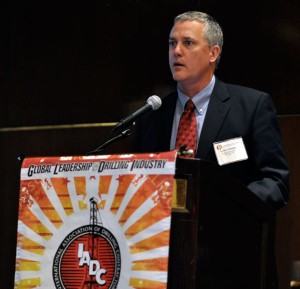Steady momentum continues in Wolfberry, Woodford, Granite Wash and Eagle Ford

“We are here to stay. We’re not here to drill this up and sell this… We’ve got 40 years of work here and a whole lot more,” Denzil West, vice president asset development for Reliance Energy, said during a panel session at the 2011 IADC Drilling Onshore Conference & Exhibition on 19 May in Houston.
Leaders from Reliance Energy, Marathon Oil Corp, Devon Energy and Petrohawk Energy offered an overview of their land assets in the Wolfberry, Woodford, Granite Wash and Eagle Ford plays during a panel session at the conference, and they’re delighted with the performance of their assets.
Privately owned Reliance currently operates and has production in more than 34,000 acres in the Wolfberry and recently acquired an additional 46,000 acres. This year’s development budget is $200 million. “We’re long-term players in West Texas,” Mr West said. “With that in mind, we have developed infrastructure around our production, putting in place our own gathering systems, our own distribution system and our own gas plant.”
“The Wolfberry play is changing, expanding aerially and vertically,” Mr West said. “There is considered to be well in excess of 10,000 (additional) acres that are productive and proven and could potentially be exploited given the right price and capital investment.” The Wolfberry play’s Spraberry Trend has been extended from 2,500 sq miles (1.6 million acres) in 1996 to 10,000 sq miles (6.4 million acres) in 2011. “If you don’t have a rig out there now in the Spraberry, I encourage you to get one,” he said.

Discussing the Woodford play in the Permian Basin, Jeff Day, worldwide drilling manager for Marathon, commented, “If you look at the liquid-rich resource plays, that’s where the money is these days. The main activity is in the Cana area. You’ll see activity all across this play as time progresses.”
These prolific plays do come with challenges. While it’s not hard to drill wells here, completion is all important. “Drilling was 70% of the well and completion was maybe 30%. The Woodford is 65% completions versus drilling,” Mr Day said. “We’ve got to push our completion people to come up with new innovations.”
Presenting recent activity in the Granite Wash play, Steve Chesher, vice president of drilling, central division for Devon, noted that his company drilled a first well in December 2006, and a total of 11 wells were drilled before commodity prices went down. Devon then took a hiatus and came back into the play in December 2009 with a revised casing program, switched to oil-based mud, conducted continuous analysis of bit performance and instituted vendor enhancements.

“The biggest risk in the whole play is take-away capacity — how to get oil and gas to market. Also, increasing costs must be offset by operational efficiencies, and oil-based mud cuttings disposal and water issues must be taken into consideration,” Mr Chesher said. “While this is a high rate-of-return, if not the highest rate-of-return, play in the company, there’s still a lot of take-away capacity. It’s still about making money and the big picture.”
Petrohawk has 347,600 net acres in the Eagle Ford play and has “grown from a two-rig program to spending $900 million on drilling and completion,” Morgan O’Brien, drilling manager western region for Petrohawk, said. “That’s approximately 170 wells.”
“We were charged by executive management in January 2008 to find another Haynesville-like play,” Mr O’Brien said. In September 2008 the company had one rig drilling an exploratory well in the Hawkville area of the Eagle Ford; from 2008 through 2009 Petrohawk drilled approximately 35 wells, and 2010 was a bit more active.”
This year, the company planned to have 12 rigs working during the first half and 16 rigs working during the second half. A total of 84 net operated wells and five net non-operated wells were planned in the Eagle Ford for 2011. Throughout 2010, 70 wells have been drilled in the Hawkville field and 37 wells were drilled in the Black Hawk field. “We’ve gone through a number of revised well plans,” Mr O’Brien said. “Nine out of 10 wells that we drill are without intermediate casing. We average 1,000 ft per day.”





